Dendrobium Nobile orchids are relatively easy to care for and can do well in most households. You may not be aware of this, but Dendrobium orchids comprise one of the largest orchid groups there is, with over 2,000 different species.
In terms of care, Dendrobium Nobile orchids prefer medium to high-light and temperatures between 65 to 75 degrees Fahrenheit during the day, with a 15 degree temperature drop at nights. During the growing season, these orchids like to be watered frequently, but need a winter rest in order to bloom.
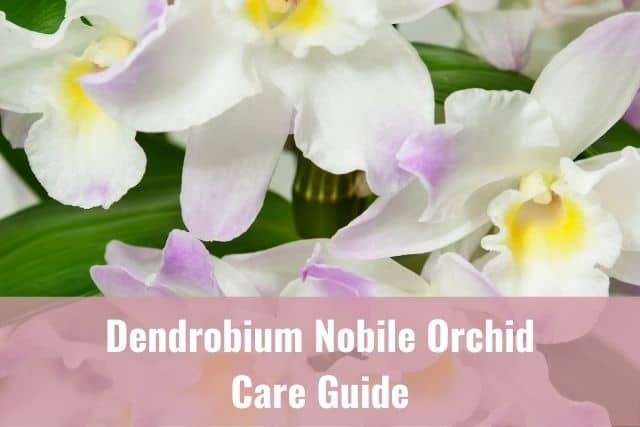
Dendrobium Nobile orchids are just one of the species within this group of orchids, but it is one of the most beginner-friendly orchids there is. If you are new to orchids, or are unfamiliar with this particular species, you’ve come to the right place.
In this orchid care guide, I’ll go over everything you need to know in order to care for your Dendrobium Nobile orchid, from lighting to watering and repotting to propagation. Keep reading to learn more.
Please note that these links are affiliate links and as an Amazon Associate, I earn from qualifying purchases. Purchases made through affiliate links in this post may generate commissions at no additional cost to you. Use this link for a discounted Amazon Prime trial. Thank you for your support!
Table of Contents
Dendrobium Nobile Orchids And Their Blooms
Unlike other Dendrobium orchids, Dendrobium Nobiles are soft-caned orchids. Their flowers grow directly on the canes, rather than on flower spikes.
Another difference Dendrobium Nobiles have is that their leaves are soft, thin and flexible. This is unlike the thick, stiff leaves of the Dendrobium Phalaenopsis orchid.
If you are ever unsure what kind of Dendrobium orchid you have, use the flowers and leaves to help you distinguish between the different Dendrobium species.
Like many Dendrobium orchids, Dendrobium Nobiles have multiple canes. Numerous flowers bloom along those canes each year. In fact, up to 50 flowers can bloom on one cane, creating an incredibly beautiful display during the blooming season.
Dendrobium orchid flowers come in a variety of colors, ranging from pink and white, to purple, lavender and brown. The flowers are a popular garnish in Hawaiian and Asian dishes. They are also used in leis, bouquets and wedding decorations.
Stake The Canes
Be aware that the sheer number of blooms on each cane, along with the multiple canes, can make the orchid very top-heavy.
To deal with this, make sure that you stake the canes. Use an orchid stake with clips to help support the cane and prevent it from leaning too heavily to one side. When placing the stake, be careful not to damage the roots.
If your orchid is potted in a plastic pot, I would recommend double potting it. This simply means that you would place your orchid pot in a larger, heavier pot to stabilize it and provide more base support. Double potting will help prevent the orchid from toppling over as it grows.
Blooming Season
These flowers typically bloom in late winter to early spring. They can last anywhere from 6 to 8 weeks before they start to fall off.
To help ensure that your flowers last longer, keep your flowering orchid away from cigarette smoke or sources of ethylene gas, like ripe fruit. You can read more here about what makes orchid flowers fall off early.
How Do You Get A Dendrobium Nobile Orchid To Bloom?
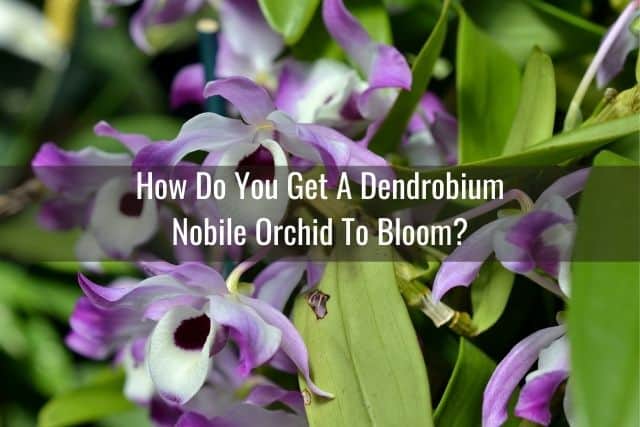
One of the most important ways you can get your orchid to bloom is to give it a nighttime temperature drop.
With a Dendrobium Nobile orchid specifically, you need to expose it to nighttime temperatures of 50 degrees Fahrenheit or slightly lower for at least a month.
This temperature drop in the fall is absolutely necessary in order to get your orchid to bloom in the late winter or early spring.
Inadequate day-night temperature differences will cause your orchid to not bloom the following season. Instead, the orchid will form keiki orchids along its cane. These little plantlets are how you can propagate an orchid, which, while not a terrible trade-off, may not be what you want to see.
Secondly, your orchid needs to be exposed to lots of bright, indirect light in order to harvest the energy it needs to produce blooms. If you have exposed it to a nighttime temperature drop and it still hasn’t produced blooms, try supplementing with artificial lighting and see if that helps.
Last, but not least, did you give your orchid a winter rest? Does it need one? Depending on what type of Dendrobium Nobile orchid you have, and whether or not it is a hybrid, it may need a winter rest. Check out the section below on “winter rest” to learn more about this concept and what your orchid needs from you at this time.
What Do You Do With A Dendrobium Orchid After Blooming? Should You Prune It?
After your Dendrobium Nobile has finished blooming, leave the canes on the orchid. Even though the flowers are gone, the canes are still functioning as a water-storage organ for your orchid. Do not cut them off.
In Dendrobiums, these canes are also known as pseudobulbs. They are necessary to get the orchid through periods of drought or dry spells, such as what they will experience during their winter rest.
While you do not want to cut off these canes after the flowers are gone, you do want to do some routine pruning and maintenance of your orchid to keep it healthy.
Using sharp, sterilized scissors or gardening shears, prune off any obvious dead tissue, including leaves and stems. Cover the cut ends of the orchid with ground cinnamon powder to help seal off the open areas and prevent infection.
Temperature Requirements of Dendrobium Nobile Orchids
Dendrobium Nobile orchids do well in most households because their preferred temperature range aligns with what many people use for their homes. These orchids do best with temperatures ranging from 65 to 75 degrees Fahrenheit during the day, and temperatures down to 55 to 60 degrees at night.
If your home’s nighttime temperatures don’t go down to 60 degrees at night, you can still meet your orchid’s temperature needs by leaving it near an open window at night.
If you live in a mild climate where nighttime temperatures don’t drop below 50 degrees, you can even leave these orchids outdoors.
Even if you live in areas where it snows, you can leave your Dendrobium orchid outdoors during the summer and early fall. Just be sure to bring it indoors before the first frost hits.
Lighting Needs of Dendrobium Nobile Orchids
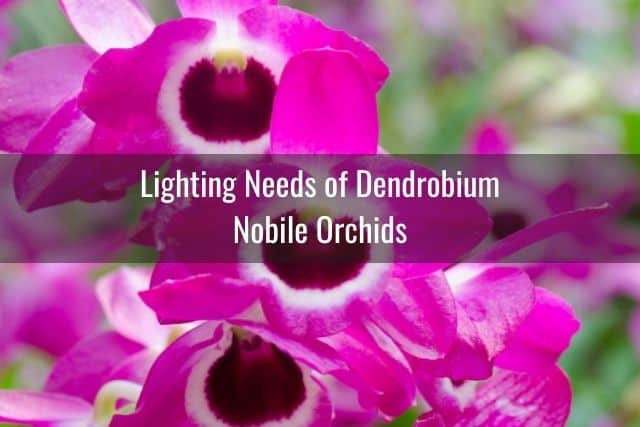
In general, Dendrobium Nobile orchids prefer lots of bright, indirect light. This is a medium to high-light orchid and can tolerate a good amount of light. In other words, these orchids would not do well in shaded areas, so avoid low-light areas.
Where Is The Best Place To Put A Dendrobium Orchid?
Ideally, you would want to place your orchid near a south-facing window that is covered by a thin curtain. The thin fabric will allow light to come through while protecting your orchid from direct sunlight.
If you don’t have a south-facing window, a west-facing window would a good the second choice, followed by an east-facing window as third choice.
What if you only have north-facing windows? Well, typically, north-facing windows don’t get much sunlight. It won’t be enough light for a Dendrobium orchid. If this is all you have in your home, you may want to consider using artificial lighting for your Dendrobium Nobile.
When positioning your orchid in the room, you also want to make sure it is not crowded up against other plants. Space the pots far enough so that there is room for adequate airflow around each pot. This will go a long way in preventing bacterial and fungal growth.
If you are placing your orchid by the window, avoid letting the leaves or canes touch the window pane. Contact with a cold window pane, especially during the winter, can lead to cold damage on the orchid.
Watering Your Dendrobium Nobile Orchid
During the growing period, many Dendrobium Nobiles like to be watered frequently, about once or twice a week. Soak the orchid pot in water for at least 5 minutes during each watering session. Let the water run out of the pot. Use luke-warm or room temperature water. Stay away from watering your orchids with ice cubes, as this can damage the orchid over time.
Try to water your orchid in the mornings so that the excess water has time to drain away before nightfall. In addition, keep an eye on the potting media and don’t let it dry out completely. You want to water your orchid again when the potting media is nearly dry.
Once the growing season ends and you start to enter the cooler fall months, decrease watering down every other week. Depending on what kind of Dendrobium Nobile orchid you have, you may even need to stop watering completely and give it a winter rest. Decreasing watering is an important part of getting your Dendrobium Nobile to rebloom.
When you see flower buds start to form, this is a sign that the blooming period has begun. You can start to increase your watering frequency during this time. Start with watering once a week. Then transition to watering once or twice a week during the growth season (which comes after the blooming season is done).
Does The Dendrobium Nobile Need A Winter Rest?

Yes, many Dendrobium Nobiles will need a winter rest period. A winter rest entails exposing your orchid to a nighttime temperature drop down to 50 degrees Fahrenheit, or 10 degrees Celsius, for at least a month. You will also need to stop watering and fertilizing your orchid during this time. Put your orchid in a location where it will be exposed to lots of bright, indirect light.
During the winter rest, keep an eye on the canes. If they start to show signs of drying out, then you will need to water your orchid. Water your orchid just enough so that the orchid canes can rehydrate. Soaking the orchid pot in water for just a few minutes should be enough.
The exception to the winter rest rule would be if you have a newer hybrid. Newer hybrid Dendrobium Nobiles can continue to be watered each week during the winter, so make sure you know what kind of Dendrobium Nobile you have.
After the winter rest is over and the Dendrobium orchid has started to develop new growth, you will want to thoroughly water your orchid. Do this by soaking your orchid pot in water for at least 10 minutes. This will give the roots and potting media a chance to absorb as much water as possible after the dry period and get rehydrated.
Humidity Requirements of Dendrobium Nobile Orchids
These orchids prefer a slightly higher humidity level than Phalaenopsis orchids. Dendrobium Nobile orchids do best with a humidity level between 50 to 70 percent.
If you aren’t sure what your home’s humidity levels are, you can solve that problem easily by using a hygrometer.
A hygrometer will measure the humidity levels in the surrounding area and are a must-have for any orchid grower. They are relatively inexpensive. Many hygrometers can also measure temperature and keep track of humidity and temperature levels over a 24-hour period.
The humidity levels in many people’s homes is usually under 50%, and drops even lower during the fall and winter time. You can increase humidity levels in your Dendrobium’s growing area by using a humidifier or humidity tray.
Humidity can often be overlooked when caring for orchids, but don’t discount it. The right humidity levels are key to helping your orchid grow and thrive.
If you are curious to learn more, read this article about why humidity is so important for your orchid.
Fertilizing Needs
Fertilize your Dendrobium Nobile with a weak orchid-specific fertilizer once a week during the growing season, which starts when you start to see flowers developing on your orchid.
During the fall, use a bloom-booster fertilizer for orchids. These fertilizers have a higher concentration of phosphorus, which the orchid uses to develop blooms.
As the orchid’s growth slows, usually during the fall and winter, you want to fertilize your orchid less frequently, such as once a month.
For more information about how to fertilize your orchid, click here.
Potting And Repotting Your Dendrobium Nobile Orchid
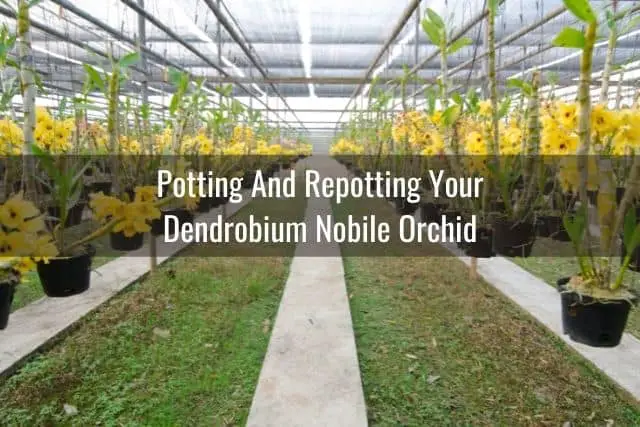
Dendrobium orchids like to be pot-bound and not disturbed. When it comes to repotting, unlike other orchids, Dendrobiums don’t need to be repotted every year. Instead, repot only once every two to four years, when it is clear that the orchid has outgrown its pot or the potting media needs replacing.
When you do repot your orchid, wait to do so after the blooming season is over. Repotting your orchid while it is still in bloom can cause the flowers to fall off early.
Once you’ve decided to repot your orchid, use the following tips to ensure your success:
Choose an orchid pot that is just slightly larger than the orchid root ball.
Use orchid-specific potting media for your orchid, not potting soil. You want to choose a potting media that is fast-draining and will allow for air to circulate among the roots. For example, this one made by Sun Grow is specially made for a variety of orchids, including Dendrobiums.
In addition, try to select a taller orchid pot. This will help support the tall canes and flowers that will later grow on your Dendrobium. If you can’t find a tall orchid pot with holes, just use what you have and then double pot it for support.
Don’t make the mistake of choosing a large, wide pot for your orchid, thinking that it will grow into it. Dendrobium orchids grow taller, not wider, and their roots are thin and small. Using a pot that is too big or wide will just increase the risk for root rot down the line.
Propagating More Dendrobium Orchids
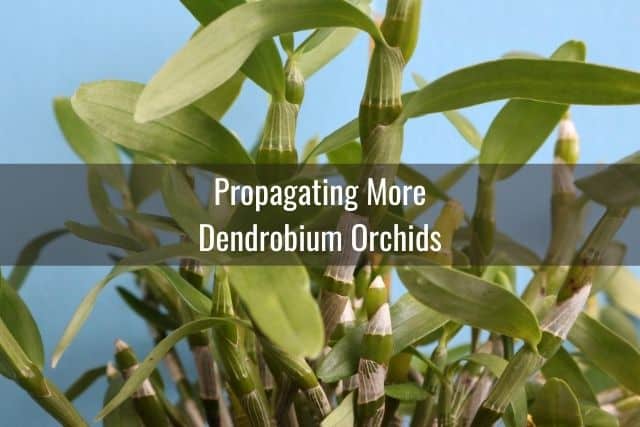
Usually, a healthy, growing Dendrobium will produce one new cane each year. After your orchid is done blooming and all the flowers have fallen off, leave the canes intact on your orchid. This is because plantlets, or keikis, can grow along the sides of older Dendrobium orchid canes.
Once the keikis have grown roots at least 2 to 3 inches in length and have several leaves, you can remove them from the orchid. Then, plant your Dendrobium keiki in it’s own little orchid pot and wait for it to grow. In time, it will produce its own blooms.
Check out this guide on how to propagate orchids to learn the step-by-step method to properly remove your orchid keiki and transition it to its own pot.
What To Do If Keikis Appear Instead Of Flowers
Be aware that keikis can appear if the orchid is not getting enough light.
If your orchid is producing keikis instead of flowers during the late winter and early spring, when it’s normally the blooming season, your orchid is trying to tell you something. Check how much light your orchid is getting. Most likely, the problem is inadequate lighting.
To address this, you may need to change the location of your orchid. Put it somewhere where it can get more light during the day.
If it is already in the best, most well-lit place in your house, then it is possible the light is just not bright enough to meet your orchid’s needs. You will likely need to use artificial lighting to help your orchid produce blooms next season.
Help! My Dendrobium Orchid Is Losing All Its Leaves
The Dendrobium Nobile orchid is deciduous, meaning that it will drop some leaves at the end of each year, before it begins to bloom again. This is perfectly normal and not a cause for concern!
This typically happens in the fall, just before the orchid’s winter rest period. During this time, growth is slowing down.
Depending on the type of Dendrobium Nobile you have, your orchid may lose all of its leaves or just some. Newer Dendrobium Nobile hybrids will keep some of their leaves, whereas older varieties will lose all of their leaves.
Having some or all of the orchid’s leaves turn yellow and fall off may cause some panic for orchid growers new to this species. It does look like the orchid is dying when this happens.
However, if it is fall and the rest of the orchid appears healthy, meaning no pests or signs of disease that you can see, don’t panic. Wait a while and leave the bare canes alone. Once the orchid finishes its winter rest, you will see blooms start to form and new leaves start to grow.
Final Thoughts
If you are looking to grow your orchid collection and expand away from Phalaenopsis orchids, give the Dendrobium Nobile orchid a try. It is a good beginner orchid and its growing requirements aren’t too difficult to meet. In fact, now you know all about how to care for Dendrobium Nobile orchids and what to expect. Hopefully this guide has helped you. As always, happy orchid growing.
If you enjoyed this article, please pin it and share!




